To capture great photos of active kids on your mobile, use burst mode to snap multiple shots quickly. Anticipate their movements and be ready to shoot at any moment. Adjust your shutter speed to freeze action or create artistic blur. Find good lighting, preferably natural, to enhance your images. Get down to the children's eye level for more engaging shots. Incorporate props or activities to keep them entertained. Experiment with different angles for unique perspectives. Don't forget to capture candid moments for genuine expressions. Finally, edit your photos to emphasize motion and energy. These tips will help you take your mobile photography to the next level.
Use Burst Mode
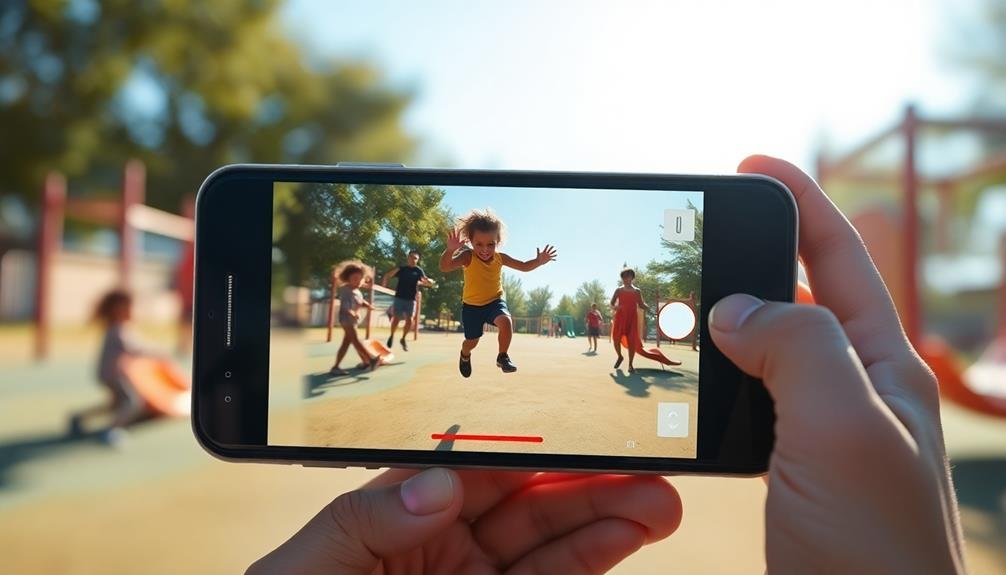
Capture the perfect shot by utilizing burst mode on your camera. This feature allows you to take multiple photos in rapid succession, increasing your chances of getting that one magical moment. To activate burst mode on most smartphones, simply press and hold the shutter button. Some devices may require you to enable this feature in your camera settings.
When photographing active children, burst mode is especially useful. Kids move quickly and unpredictably, making it challenging to time your shots perfectly. By taking a series of photos in quick succession, you're more likely to capture their genuine expressions, spontaneous actions, and fleeting moments of joy.
After using burst mode, review the sequence of images and select the best ones. Look for natural smiles, interesting compositions, and sharp focus.
Don't be afraid to experiment with different angles and distances while using burst mode. You can capture full-body shots of children running or playing, as well as close-ups of their facial expressions during various activities.
Remember to keep your camera steady and anticipate your subject's movements for the best results.
Anticipate the Action
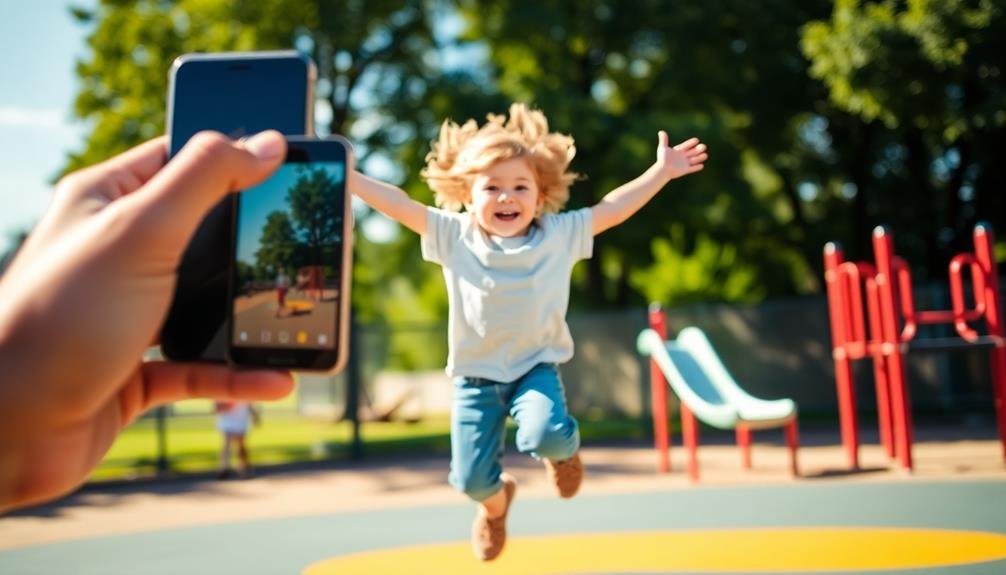
While burst mode increases your chances of capturing great shots, anticipating the action takes your photography to the next level. To master this skill, observe your children's behavior and patterns. Notice how they move, where they tend to play, and what activities excite them most. This knowledge will help you predict their next moves and position yourself accordingly.
Pay attention to the environment and potential photo opportunities. If you're at a playground, scout out areas where kids are likely to run, jump, or slide. At sporting events, familiarize yourself with the game's flow to predict key moments.
Don't forget to take into account lighting conditions and backgrounds that'll enhance your shots.
Practice following the action with your camera, keeping your subject in frame as they move. This technique, known as panning, can result in dynamic images with a sense of motion. Experiment with different shutter speeds to capture varying degrees of blur in the background.
Lastly, be patient and stay ready. Children's actions can be unpredictable, so maintain a state of readiness. Keep your camera app open and your finger poised to capture those fleeting, magical moments that define childhood.
Adjust Shutter Speed Settings
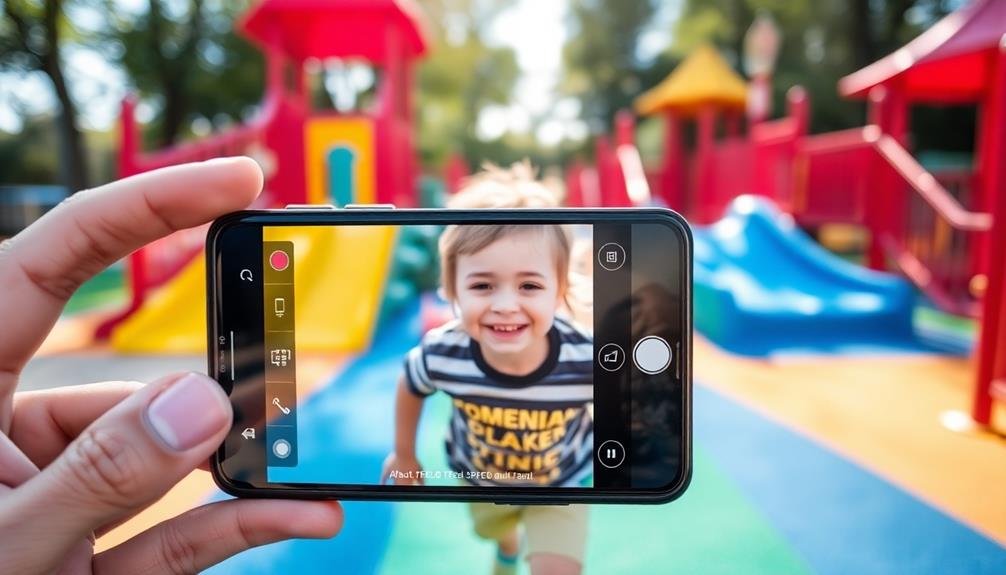
When photographing active children, adjusting your shutter speed is essential.
You'll want to use a fast shutter speed to freeze motion effectively, capturing crisp images of running, jumping, or playing kids.
Alternatively, you can experiment with slower shutter speeds to create intentionally blurred action shots, though keep in mind that phone cameras may have limitations in manually adjusting these settings.
Freeze Motion Effectively
To freeze motion effectively when photographing active children, mastering shutter speed settings is essential. On most mobile phones, you'll need to use a third-party camera app that allows manual control over shutter speed. Aim for speeds of 1/500th of a second or faster to capture sharp images of running, jumping, or playing kids.
In bright outdoor conditions, you can typically use faster shutter speeds without compromising image quality. However, in lower light, you'll need to balance shutter speed with ISO to maintain proper exposure. Increase ISO as needed, but be cautious of introducing too much noise.
Anticipate the action and pre-focus on the spot where you expect the child to be. This technique, combined with a fast shutter speed, will help you capture crisp, clear images. If your phone has burst mode, use it to increase your chances of getting the perfect shot.
Remember that freezing motion isn't always necessary. Sometimes, a slight blur can convey a sense of movement and energy in your photos. Experiment with different shutter speeds to find the right balance between freezing action and capturing the dynamic nature of children at play.
Capture Blurred Action Shots
Capturing blurred action shots can add a dynamic and artistic element to your photos of active children. To achieve this effect, you'll need to adjust your camera's shutter speed settings. Most smartphones allow you to control shutter speed through the manual or pro mode in your camera app.
For blur, use slower shutter speeds like 1/15 or 1/30 of a second. This allows more light to enter the camera, creating a motion trail as your subject moves. Experiment with different speeds to find the right balance between blur and clarity.
Here's a quick guide to shutter speeds and their effects:
| Shutter Speed | Effect | Best For | Challenges |
|---|---|---|---|
| 1/15 | Significant blur | Running, jumping | May be too blurry |
| 1/30 | Moderate blur | Swinging, sliding | Requires steady hand |
| 1/60 | Slight blur | Dancing, twirling | Less dramatic effect |
| 1/125 | Minimal blur | Gentle movements | May not show motion |
Remember to keep your camera steady while shooting. You can also try panning, following your subject's movement to keep them in focus while blurring the background. This technique takes practice but can result in stunning action shots.
Understand Phone Camera Limitations
Most smartphone cameras have limitations when it comes to adjusting shutter speed settings. While newer models offer some manual controls, many phones still lack the ability to directly set shutter speeds. This can make capturing fast-moving children challenging, as you can't always freeze or blur motion as desired.
To work around these limitations, you'll need to get creative. Use your phone's "burst mode" to take multiple shots in quick succession, increasing your chances of capturing the perfect moment. Experiment with third-party camera apps that offer more advanced controls, including manual shutter speed adjustments on compatible devices.
In low light situations, your phone's camera will automatically slow down the shutter speed, which can lead to blurry photos of active kids. Combat this by finding well-lit areas or using additional lighting sources. When possible, encourage children to play in brighter spaces to allow for faster shutter speeds.
Remember that your phone's camera sensor is smaller than those in DSLRs, affecting its ability to capture fast action. Compensate by anticipating movements and pre-focusing on areas where you expect the action to occur.
With practice and these techniques, you can overcome your phone's limitations and capture stunning photos of active children.
Find Good Lighting
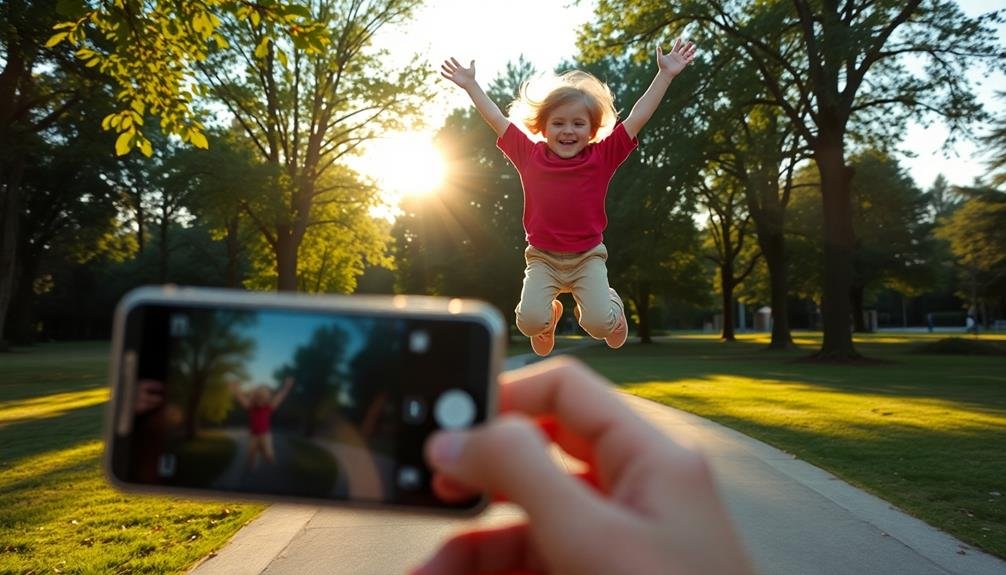
When photographing active children, natural light is your best friend.
You'll want to avoid harsh shadows that can obscure facial features or create unflattering contrasts. If you're indoors, position your subjects near windows to take advantage of soft, diffused illumination that'll flatter their skin and bring out the sparkle in their eyes.
Natural Light Is Best
Natural light's magic can transform your photos of active children. When shooting outdoors, aim for the golden hours just after sunrise or before sunset. During these times, the soft, warm light creates a beautiful glow on your subjects' skin and adds depth to your images.
Avoid harsh midday sun, which can cast unflattering shadows and cause squinting.
If you're indoors, position your little ones near windows or glass doors to take advantage of the available natural light. Turn off artificial lighting to prevent color casts and maintain a more natural look.
Cloudy days are perfect for outdoor shoots, as they provide soft, diffused light that's flattering for portraits.
Here are four tips to make the most of natural light:
- Use backlighting to create a dreamy, ethereal effect
- Seek out open shade for even, soft lighting
- Experiment with side lighting to add depth and dimension
- Adjust your camera's white balance to match the light temperature
Avoid Harsh Shadows
Building on the importance of natural light, let's focus on avoiding harsh shadows to capture stunning photos of active children. Harsh shadows can create unflattering contrasts and obscure facial features, detracting from the overall image quality. To minimize these shadows, position your subjects in areas with diffused light, such as under a tree or in the shade of a building.
When shooting outdoors, time of day plays a significant role. Early morning or late afternoon offer softer, more flattering light. If you're shooting midday, seek out shaded areas or use a diffuser to soften the light. Indoors, position your subjects near windows for gentle, natural illumination.
Consider the direction of light when composing your shots. Side lighting can create interesting dimensionality, while front lighting minimizes shadows but may cause squinting. Experiment with different angles to find the most flattering light for your subjects.
| Lighting Condition | Best Time | Tips |
|---|---|---|
| Outdoors – Sunny | Early morning / Late afternoon | Use shade or diffuser |
| Outdoors – Overcast | Anytime | Ideal for even lighting |
| Indoors – Natural light | Mid-morning / Early afternoon | Position near windows |
| Indoors – Artificial light | Anytime | Use soft, diffused sources |
Use Window Illumination
Window illumination offers photographers an excellent source of natural light for capturing stunning images of active children indoors.
It's soft, diffused, and flattering, making it ideal for highlighting your child's features without harsh shadows. To make the most of window light, position your subject facing or at a 45-degree angle to the window. This placement guarantees even illumination across their face and body.
When using window light, consider these tips:
- Time of day matters: Early morning or late afternoon light tends to be warmer and more flattering.
- Avoid direct sunlight: If the sun's rays are too strong, use sheer curtains to soften the light.
- Experiment with side lighting: Position your child perpendicular to the window for dramatic shadows and depth.
- Use reflectors: Bounce light back onto your subject's face with a white sheet or foam board to fill in shadows.
Get Down to Eye Level
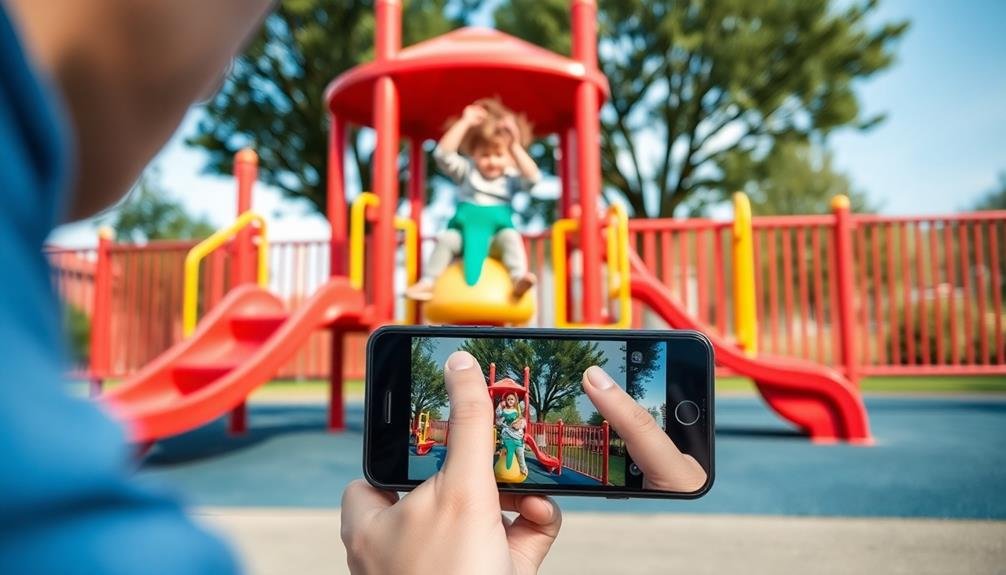
Crouching, kneeling, or even lying on the ground can dramatically improve your photos of active children. By getting down to their eye level, you'll capture their world from their perspective, creating more engaging and intimate images. This approach allows you to connect with your subjects on a personal level, resulting in more natural expressions and genuine emotions.
When you're at eye level, you'll notice details you might've missed from a standing position. You'll see their facial expressions more clearly and capture the sparkle in their eyes. This technique also helps to eliminate distracting backgrounds by blurring them out, keeping the focus on your young subject.
Don't be afraid to get dirty or look silly – the results are worth it. If you're using a smartphone, try using the volume buttons as a shutter release to make it easier to take photos from low angles.
Remember to be quick and ready to move, as children rarely stay still for long. By adopting their viewpoint, you'll create more dynamic and interesting photos that truly reflect the energy and spirit of childhood.
Focus on the Eyes
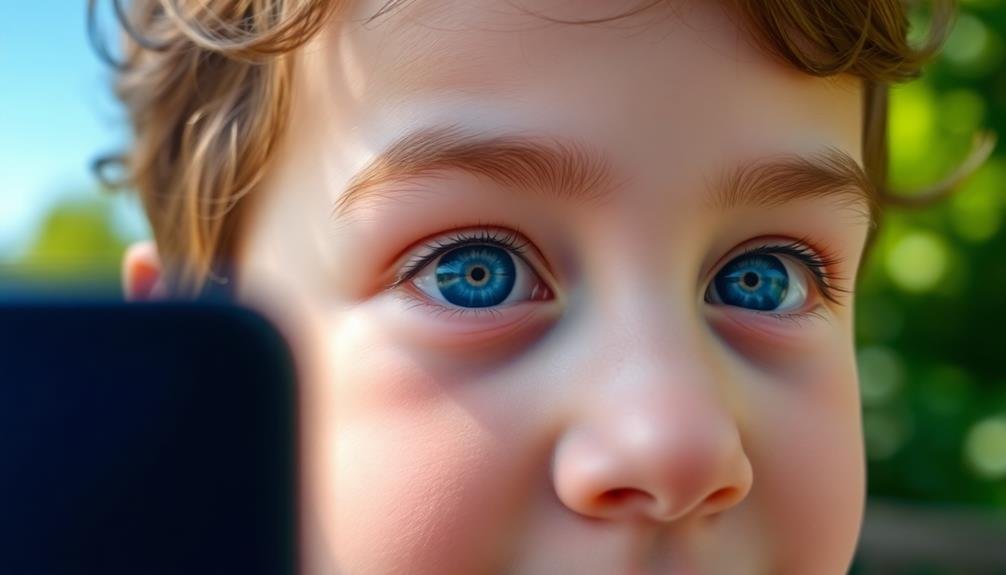
To capture sharp, engaging photos of active children, you'll want to focus on their eyes.
Start by enabling your camera's Face Detection mode, which automatically prioritizes eye focus. If needed, switch to manual focus for precise control, especially in challenging lighting conditions.
Don't miss those fleeting expressive moments—a child's eyes can tell a whole story in a single glance.
Use Face Detection Mode
Face detection technology can be a game-changer when photographing active children. Most modern smartphones come equipped with this feature, which automatically identifies and focuses on faces in the frame. When you're dealing with energetic kids who won't stay still, this mode can help you capture sharp, well-focused images even in challenging situations.
To make the most of face detection mode:
- Enable it in your camera settings before you start shooting.
- Frame your shot to include the child's entire face.
- Keep an eye on the screen to verify the face is detected.
- Be prepared to tap the screen to manually select a face if needed.
Face detection works best in well-lit environments, so try to position your subjects in areas with good natural light. If you're indoors, move closer to windows or use artificial lighting to improve detection accuracy.
Remember that this mode may struggle in low light or when faces are partially obscured, so be ready to switch to manual focus if necessary. By mastering face detection, you'll increase your chances of capturing crisp, expressive photos of your active little ones.
Adjust Focus Manually
While face detection mode can be helpful, sometimes you'll need to take control of focus yourself. When photographing active children, manually adjusting focus allows you to prioritize the most important elements in your shot.
For portraits, always focus on the eyes. They're the windows to the soul and should be tack-sharp in your images.
To adjust focus manually on your mobile device, tap the screen where you want to focus. Most phones will display a square or circle indicating the focus point.
For moving subjects, try to anticipate where they'll be and focus on that spot in advance. If your phone has a pro or manual mode, you can often lock the focus, allowing you to recompose your shot without losing focus on your subject.
Remember that depth of field plays a significant role in focus. A wider aperture (lower f-number) creates a shallower depth of field, which can help isolate your subject from the background.
However, this also means less of the image will be in focus, so you'll need to be extra precise with your focusing.
Practice and experiment with different focus techniques to capture those fleeting moments of childhood energy and joy.
Capture Expressive Moments
Capturing expressive moments is the key to creating memorable photographs of children. When you're aiming to capture these fleeting instances, focus on the eyes. They're often called the windows to the soul for a reason, and they'll convey the most emotion in your photos.
To capture expressive moments effectively, keep your camera ready at all times. Children's moods and expressions can change in an instant, so you'll need to be prepared to snap that perfect shot at a moment's notice.
Here are four tips to help you capture expressive moments:
- Engage with the child to elicit genuine reactions
- Use burst mode to capture a series of expressions
- Get down to the child's eye level for more intimate shots
- Look for candid moments during play or interaction with others
Don't be afraid to take lots of photos. With digital photography, you can always delete the ones that don't work out.
Use Props and Activities
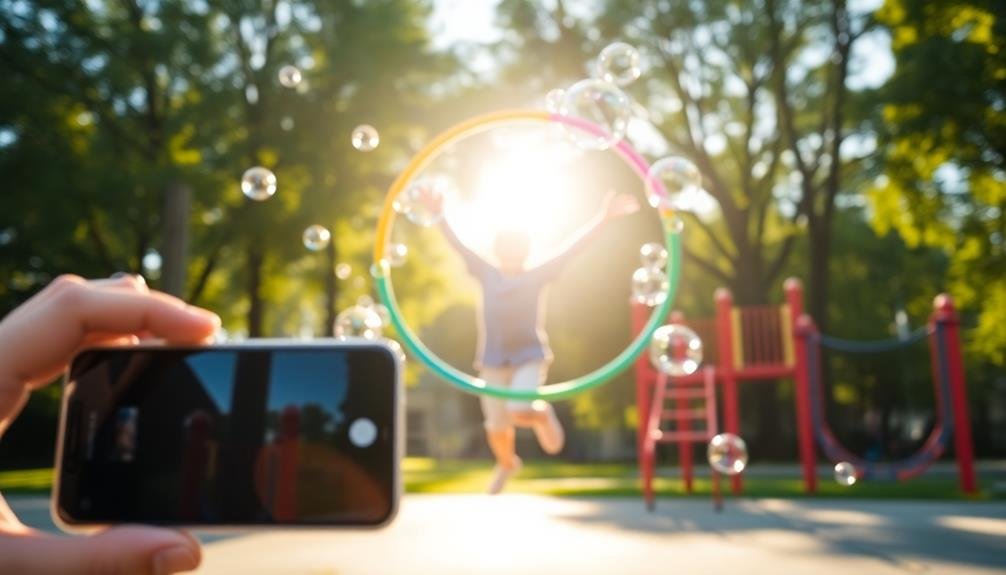
How can you keep active children engaged during a photoshoot? Incorporating props and activities is a fantastic way to capture natural, lively images while keeping kids entertained. Choose items that match the child's interests or the photoshoot's theme.
Here's a table of prop and activity ideas for different age groups:
| Age Group | Props | Activities |
|---|---|---|
| Toddlers | Bubbles, Stuffed animals | Blowing bubbles, Dancing |
| Preschoolers | Dress-up clothes, Art supplies | Playing pretend, Finger painting |
| School-age | Sports equipment, Musical instruments | Playing catch, Impromptu concert |
| Tweens | Books, Tech gadgets | Reading, Gaming |
When using props, verify they're safe and age-appropriate. Let the child interact naturally with the items, capturing candid moments as they play. For activities, choose ones that allow movement and expression. This approach not only keeps children engaged but also results in more authentic photos.
Remember to adapt quickly if a prop or activity isn't working. Have backup options ready, and don't force interactions. The key is to make the photoshoot feel like playtime, encouraging genuine smiles and capturing the child's personality in every shot.
Experiment With Different Angles
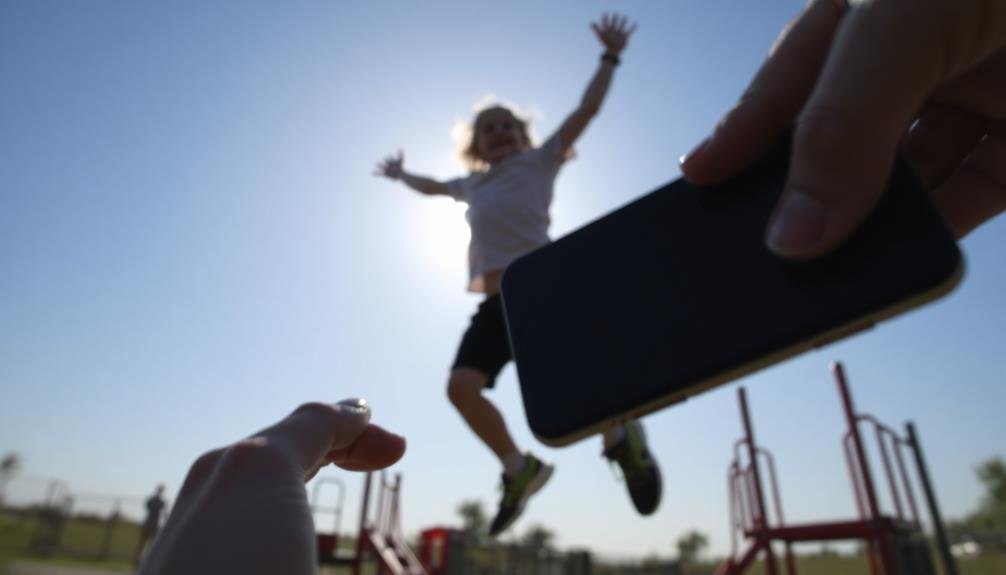
Props and activities aren't the only tools in your photography arsenal. When it comes to capturing active children, experimenting with different angles can breathe new life into your shots. By changing your perspective, you'll create unique and dynamic images that stand out.
Don't be afraid to get down on the ground or climb to higher vantage points. Here are four ways to experiment with angles:
- Shoot from below: Get on your knees or lie down to capture your child from a low angle. This perspective can make them appear larger than life and add a sense of wonder to your photos.
- Try a bird's-eye view: Climb stairs or stand on furniture to shoot from above. This angle works well for capturing multiple children playing together or showcasing intricate floor activities.
- Use diagonal lines: Tilt your phone to create dynamic diagonal compositions. This technique adds energy and movement to your images, perfect for active kids.
- Get close-up: Fill the frame with your child's face or hands to capture emotions and details. These intimate shots can be powerful and emotive.
Capture Candid Moments
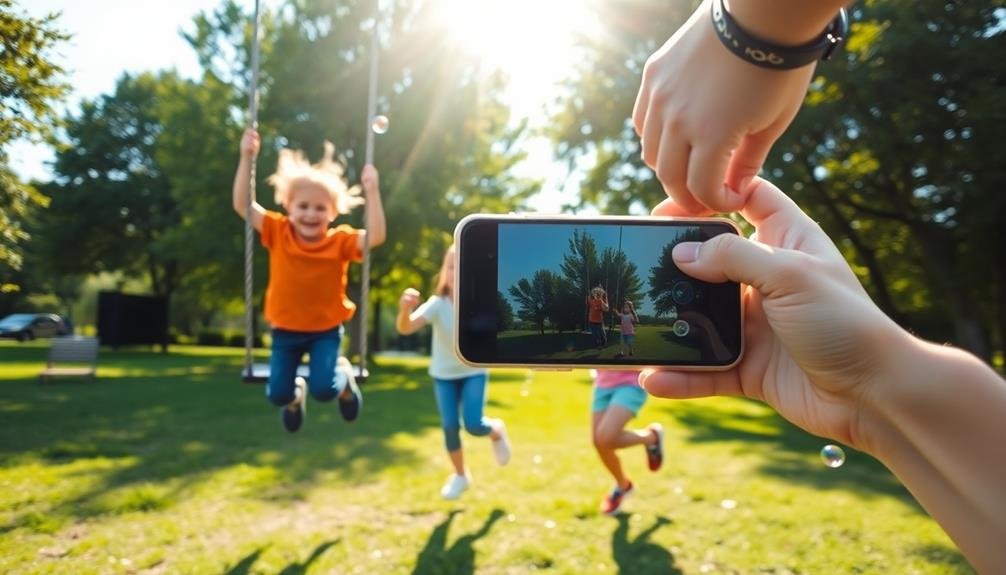
Candid moments can bring out the true essence of a child's personality. To capture these authentic snapshots, you'll need to be patient and observant. Keep your phone ready at all times, as kids are unpredictable and their most genuine expressions often occur when they're not posing.
Instead of asking children to smile or look at the camera, let them play naturally and photograph them in action. Use burst mode to capture a series of shots, increasing your chances of getting that perfect moment. Pay attention to their interactions with others and their surroundings, as these often lead to compelling images.
Here's a quick guide to capturing candid moments:
| Setting | Tips | Best For |
|---|---|---|
| Indoors | Use natural light | Quiet activities |
| Outdoors | Shoot in shade | Active play |
| Events | Anticipate reactions | Emotional moments |
Remember to respect your child's privacy and mood. If they're not in the mood for photos, don't force it. The best candid shots come when children are comfortable and unaware of the camera. By mastering these techniques, you'll create a collection of genuine, heartwarming images that truly reflect your child's personality.
Edit for Motion Effect
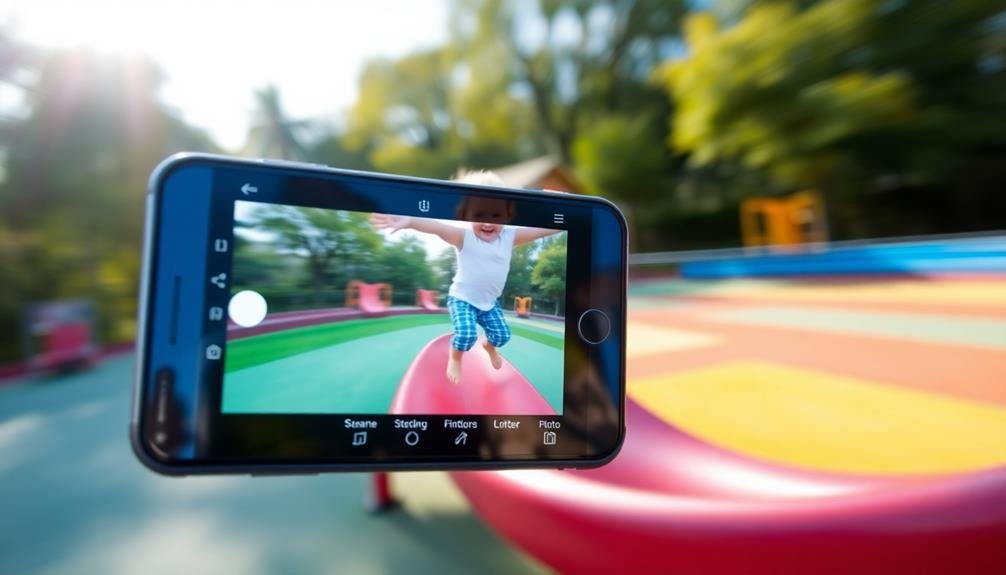
Capturing motion in still images can breathe life into your photographs of active children.
With mobile editing apps, you can enhance the sense of movement and energy in your shots. These techniques will help you create dynamic photos that truly reflect your child's vibrant personality and active lifestyle.
To edit for motion effect:
- Use motion blur: Apply a directional blur to the background or parts of your subject to create a sense of speed. This works well for running or jumping shots.
- Try long exposure effect: Simulate a longer exposure by blending multiple images or using specialized apps. This can create light trails or ghosting effects for moving subjects.
- Add motion lines: Draw or overlay subtle lines that follow the direction of movement to emphasize action. This technique works great for sports or dance photos.
- Experiment with panning effect: Mimic the look of panning by keeping your subject sharp while blurring the background horizontally. This gives the illusion of following a moving subject.
When editing, don't overdo the effects. Subtle enhancements often work best to maintain a natural look while still conveying motion.
Experiment with different techniques to find what works best for each photo and your personal style.
Frequently Asked Questions
How Can I Prevent Camera Shake When Photographing Active Children?
To prevent camera shake, you'll want to use a faster shutter speed. Hold your camera steady, brace your arms against your body, and exhale slowly as you shoot. Consider using burst mode to capture multiple shots quickly.
What's the Best Mobile App for Editing Action Shots of Kids?
You'll find Snapseed, VSCO, and Lightroom Mobile excellent for editing action shots of kids. They offer intuitive controls for adjusting sharpness, exposure, and motion blur. Try each to see which suits your style and needs best.
How Do I Photograph Multiple Active Children at Once?
To photograph multiple active kids at once, you'll want to use burst mode, find a central focal point, and engage them in a group activity. Set your camera to a fast shutter speed and be ready to move quickly yourself.
What Are the Ideal Camera Settings for Indoor Action Shots?
For indoor action shots, you'll want to use a fast shutter speed (1/250 or higher), increase your ISO (800-3200), and open your aperture wide (f/2.8-f/4). Use continuous autofocus and burst mode to capture the best moments.
How Can I Encourage Shy Children to Be More Active for Photos?
To encourage shy children, make them feel comfortable. Play games, tell jokes, or let them bring a favorite toy. Don't force poses; capture natural moments. Be patient and praise their efforts. Use fun props to spark their interest.
In Summary
You've now got the tools to capture stunning photos of active kids with just your mobile device. Don't forget to practice these techniques regularly, and you'll soon see a remarkable improvement in your shots. Remember, it's all about timing, creativity, and patience. Embrace the chaos, have fun with it, and you'll end up with images that truly reflect your children's vibrant personalities. Now go out there and start snapping those priceless moments!





Leave a Reply